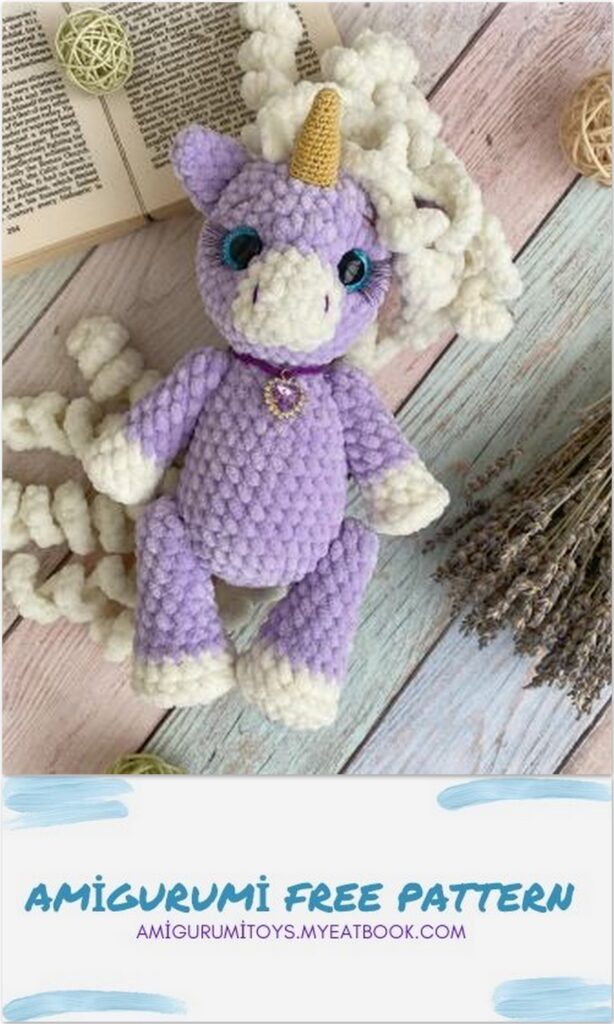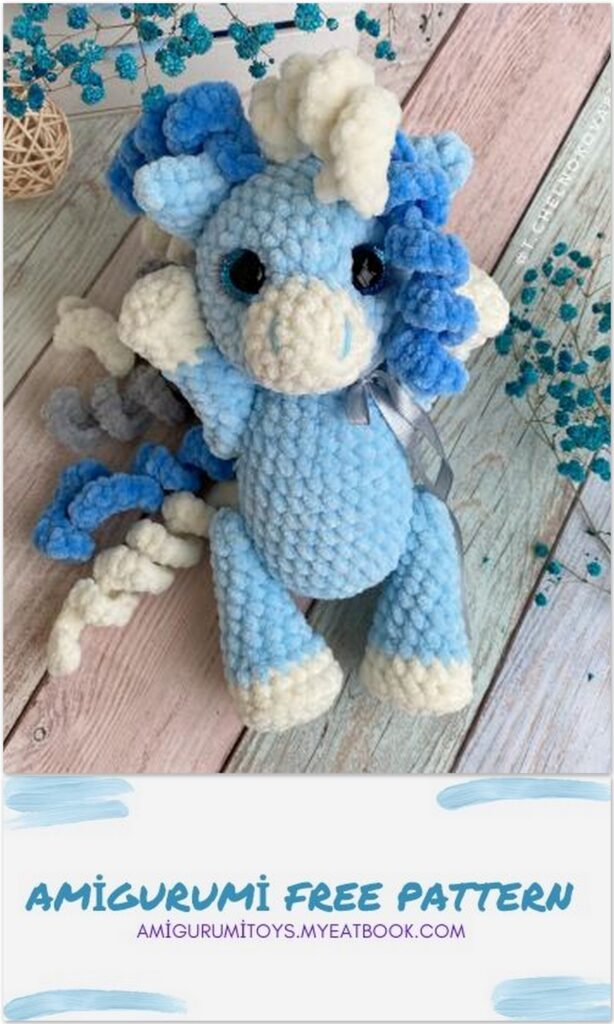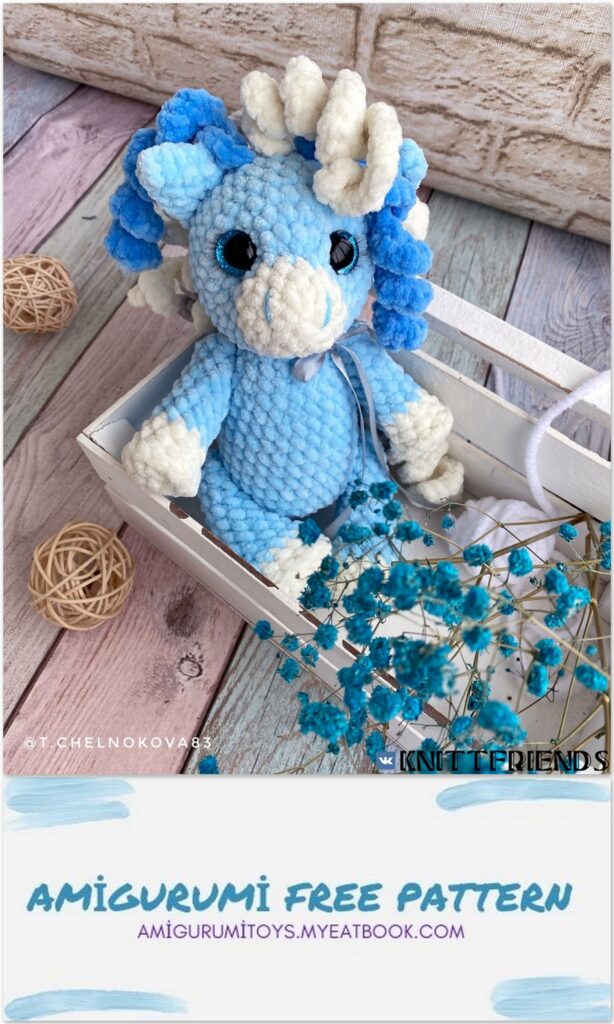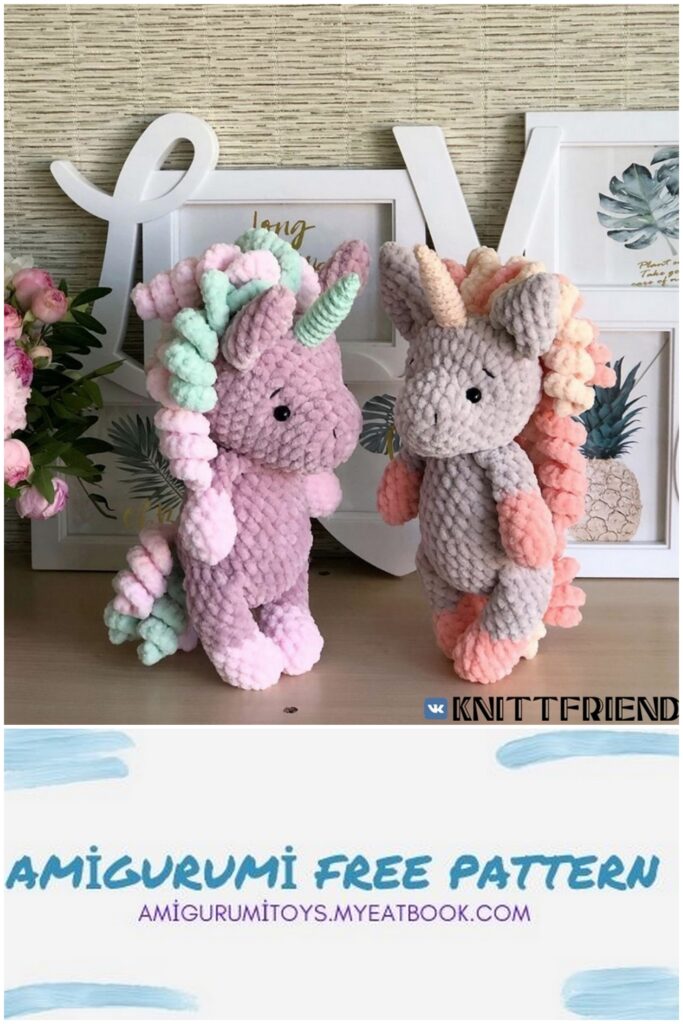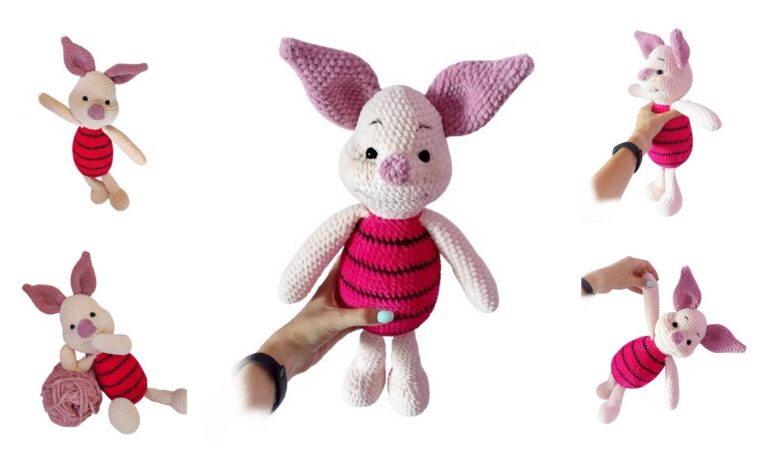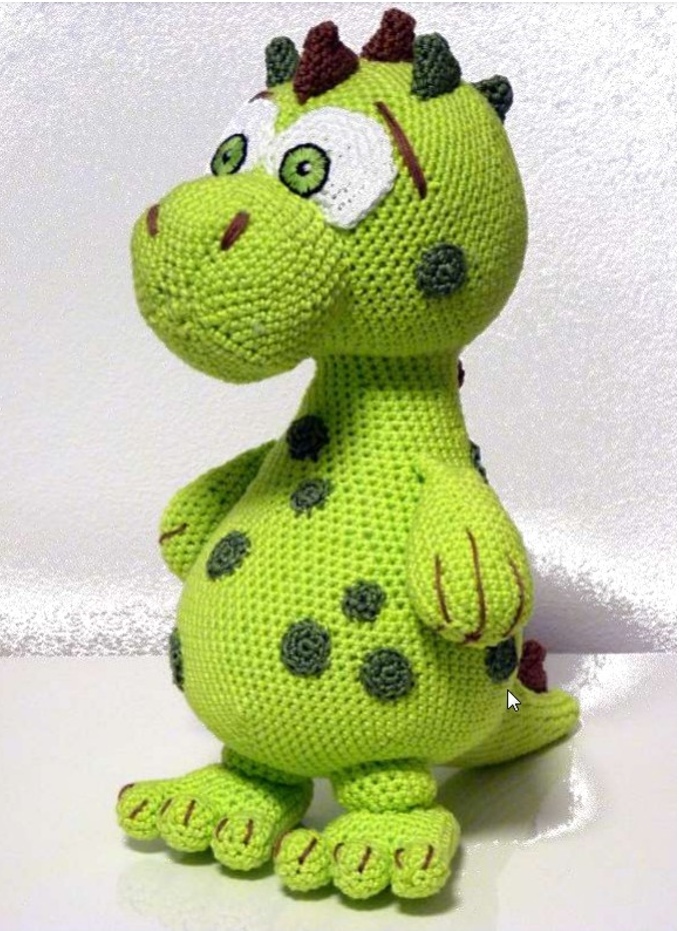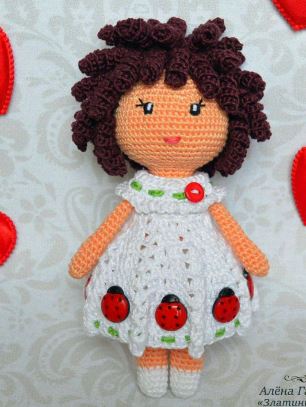Amigurumi Cute Unicorn Free Pattern
Toys Unicorn I. Preparatory work.
Amigurumi toys When using these materials, the growth of the toy is about cute unicorn 21 cm.
For work we need:
1. Skills of crocheting basic elements;
2. Plush yarn. I am using YarnArt Dolce either Himalaya Dolphin Baby (120m / 100g): Approximate consumption – 50-60 grams of the main color and 20-30 grams each additional colors;
3. Cotton yarn for muzzle embroidery, tightening, sewing on elements and knitting horns. I use “Iris” PNK them. SM Kirov and Seam “Anna 16”;
4. Hook 4-5mm for plush yarn. Navigate on its knitting density. It is necessary to choose such a hook in which there will be no holes in the canvas;
5. Synthetic fluff or other filler. When use as a filler for various granules sew them into a fabric bag;
6. Eyes on a secure mount 14-16mm and eyelashes;
7.4 buttons for button fastening of paws 13-15 mm or safety plastic fasteners 20 mm;
8. Needle with a thick eye for sewing on parts.
Important note! Yarn consumption specified in clause 1 section I, is highly subjective and depends on the density knitting, which is individual for everyone.
Legend:
MR ring amigurumi;
SC – single crochet;
PSC – Embossed single crochet purl;
İNC – increase, that is, we knit from one column 2SC;
HDC – half double crochet;
DEC – decrease, that is, we make one of two columns;
The brackets indicate the number of loops, which in will end up in a row.
All details, without exception, are knitted in a spiral.
We knit all the columns for both segments of the columns the previous row. Exception: using a method invisible decreases.
I recommend using the invisible decrease method.
Important note! The description is not a tutorial knitting, so all methods of knitting loops you need to study it yourself.
All errors and typos found in description, please inform the author.
Hind legs (2 parts):
White yarn a.
1 row: 6p in MR (6);
2nd row: İNC x 6 times (12);
3 row: (SC, İNC) x 6 times, ss (18);
4 row we knit with embossed purl columns without nakida, so we will form a beautiful angle for the hoof:
CH for lifting, (4 PSC, DEC) x 3 times (15); If a it is not possible to knit with embossed columns, then knit behind the back half-loop of the column.
5 row: 15 SC (15);
Yarn main color a.
6 row: 15 SC (15);
7 row: (3 SC, DEC) x 3 times (12);
8 row: 12 SC (12);
Row 9: (4SC, DEC) x 2 times (10);
Rows 10-14 (5 rows in total): 10 SC (10); We fill the leg with filler almost completely.
* If you will put washers for fastening limbs, then you need to set the washer between 13 and 14 nearby. Install washers so that after connection legs with a torso connecting column of the 3rd row and the places where the thread color changed were at the back. If you will be use a button fastening, then this step is necessary skip.
Row 15: DEC x 5 times (5)
Pull the hole, fasten and hide the thread inside the part
Front legs, they are also hands (2 parts):
White yarn a.
1 row: 6p in MR (6);
2nd row: İNC x 6 times, ss (12);
3 row we knit with embossed purl columns without nakida, so we will form a beautiful angle for the hoof:
CH for lifting, (2 PSC, DEC) x 3 times (9); If a it is not possible to knit with embossed columns, then knit behind the back half-loop of the column.
4-5 rows (2 rows): 9 SC (9);
Yarn main color a.
6-12 rows (7 rows): 9 SC (9);
We fill the handle leg with filler almost completely.
If you use limb washers, then you need to install the washer between 11 and 12 row.
Install washers so that after connection limbs with the trunk connecting column of the 2nd the rows and places of the thread color change were at the back.
Row 13: DEC x 5 times (5)
Pull the hole, secure and hide the thread inward details.
The torso.
Yarn main color a.
1 row: 6p in MR (6);
2nd row: İNC x 6 times (12);
3rd row: (SC, İNC) x 6 times (18);
4th row: (2 SC, İNC) x 6 times (24);
5 row: (3 SC, İNC) x 6 times (30);
6-11 rows (6 rows): 30 SC (30);
12 row: 4 SC, 3 DEC, 20 SC (27); the knitting area where you are made 3 decreases will be the booty of the animal.
If you use washers for fastening, then you need fasten the hind legs between the 5th and 6th rows of the body (on distance 13-15 SC from each other symmetrically 3 m decreases in the 12th row. Remember that there is a priest.
If you will use a button fastening, then We do not fasten anything anywhere, we just continue to knit further.
13th row: 3 SC, DEC, SC, DEC, 10 SC, DEC, 7 SC (24); In this series we also make 3 decreases. In this case, one will be located exactly in the middle of the tummy, and the other two – behind (on the pope);
Row 14: 24 SC (24);
15th row: 5 SC, DEC, 6 SC, DEC, 6 SC, DEC, SC (21);
16 row: 4 SC, DEC, 5 SC, DEC, 5 SC, DEC, SC. (eighteen);
We fill the body to the middle.
Row 17: (4 SC, DEC) x 3 times (15);
18th row: 4 SC, DEC, 4 SC, DEC, 2 SC, DEC, 3 SC (12); In this series we moved 1 SC and knitted 3 more extra at the end to keep knitting symmetrical and the hook was in the middle of the back. IN in general, 12 loops remained in the row.
Stuff the torso with filler. If using washers for fastening, then n It is necessary to fix the handles between 15 and 16 rows symmetrical. If you use a button fastening, then nothing needs to be fastened.
Row 19: DEC x 6 times (6)
Pull the hole, secure and hide the thread inward details.
Head:
White yarn a.
1 row: 6p in MR (6);
2nd row: İNC x 6 times (12);
3rd row: (3 SC, İNC) x 3 times (15);
4th row: 15 SC (15);
Yarn main color a;
5 row: (4 SC, İNC) x 3 times (18);
6 row: 2 SC, İNC, 4 SC, 4 İNC from HDC, 4 SC, İNC, 2 SC (24);
7 row: 4 SC, (İNC, 2 SC) x 5 times, İNC, 4 SC (30);
8 row: (4 SC, İNC) x 6 times (36);
9-14 rows (6 rows): 36 SC (36);
Install the eyes between 6 and 7 row so that the distance between the corners of the eyes there were 6-8 SC (that is, between the feet of the eyes – 10-12 SC.
If the fasteners are tight, then you must immediately lay threads for tightening the muzzle. How the tightening is done, you can look in the section “Assembling a toy”.
15 row: (4 SC, DEC) x 6 times (30);
16 row: (3 SC, DEC) x 6 times (24);
17 row: (2 SC, DEC) x 6 times (18);
Stuff your head with filler and then add filler as needed.
Row 18: (SC, DEC) x 6 times (12);
Row 19: DEC x 6 times (6)
Pull the hole, secure and hide the thread inward details.
Ears (2 parts).
Yarn main color a.
1st row: 4p in MR (4);
2nd row: (SC, İNC) x 2 times (6);
3rd row: (2 SC, İNC) x 2 times (8);
4th row: (3SC, İNC) x 2 times (10);
5 row: (3SC, DEC) x 2 times (8).
The second version of the ears is larger:
1st row: 4p in MR (4);
2nd row: (SC, İNC) x 2 times (6);
3rd row: (2 SC, İNC) x 2 times (8);
4th row: (3SC, İNC) x 2 times (10);
5 row: 10 SC (10);
6 row: (3SC, DEC) x 2 times (8).
Fasten the thread, hide the tip inside the ear. I recommend sew the ears to the head with cotton thread.
Horn.
Cotton yarn in matching color a.
1 row: 6p in MR (6);
2nd row: (SC, İNC) x 3 times (9);
3rd row: 9 SC (9);
4th row: (2 SC, İNC) x 3 times (12);
5 row: 12 SC (12);
6 row: (3 SC, İNC) x 3 times (15);
7-8 rows (2 rows): 15 SC (15);
9th row: (4 SC, İNC) x 3 times (18);
10-11 rows (2 rows): 18 SC (18);
12th row: (5 SC, İNC) x 3 times (21);
Rows 13-14 (2 rows): 21 SC (21);
Knit a mop, fasten the thread and leave the tip for sewing the horn to the head. Stuff the horn with filler.
Mane (10-12 pieces).
Yarn in additional colors.
We dial 25-26 CH. Starting from the second from the hook CH we knit 2 SC in each CH, fasten the thread.
We place the details on the head along the growth line of the mane 2-3 details in a row. It is best to attach the mane to the head after how you sew the head to the body. See section “Assembly toys “.
Tail (5 details).
Additional colors of yarn.
We dial 35 CH. Starting from the second from the hook CH we knit 2 SC in each CH, fasten the thread.
Assembling the toy.
Stage 1: Place the ears symmetrically with the eyes and muzzle on
3-4 rows from the eyes Ears can be positioned across or along the head. Sew the horn a little closer to muzzle than ears.
Stage 2: tightening. We start a cotton thread in the main color yarn thread in the mouth area, leave the tip. We deduce the needle from the outside of the left eye, we start the needle with the inner side of the left eye, we deduce from the inner sides of the right eye, draw out the thread. The thread should pass over the left eye, slip between the eye and yarn and lie on the leg of the eye. Next – we start the needle with the outer corner of the right eye and put it in the mouth, stepping back from the tip of the yarn 1 SC. We pull up the thread until a pleasant-looking muzzle is formed.
We tie a knot.
Stage 3: We embroider the nostrils and eyebrows.
Stage 4: Sew the head to the body under the one you need angle.
Stage 5: if you use a button fastening, then on at this stage with the help of buttons it is necessary to fasten limbs. When performing this kind of fastening
I recommend using a thin line along with the thread.
I use 13-15mm buttons and a long needle.
First of all, I start to fix the “arms”. They are located closest to the muzzle, which means they are easier place the muzzle symmetrically.
I start with the left paw. I always put the needle on the other side which will be in contact with the body. They brought in the needle, brought out on the other hand, threaded a button, returned the needle to the same hole.
Now you need to thread the needle and thread through the trunk is symmetrical.
Next, the second paw, button and needle are strung onto the needle returns back through the torso to the left paw. Knot
I do it under my armpit and stretch the ends together with the knot inside the left foot.
I strengthen my “legs” according to the same principle. Between 5 and 6 rows torso.
Stage 6: Form and sew on the tail and mane.
The unicorn is ready! Not difficult, right? Magic yes only…
I look forward to your comments, feedback and suggestions!

